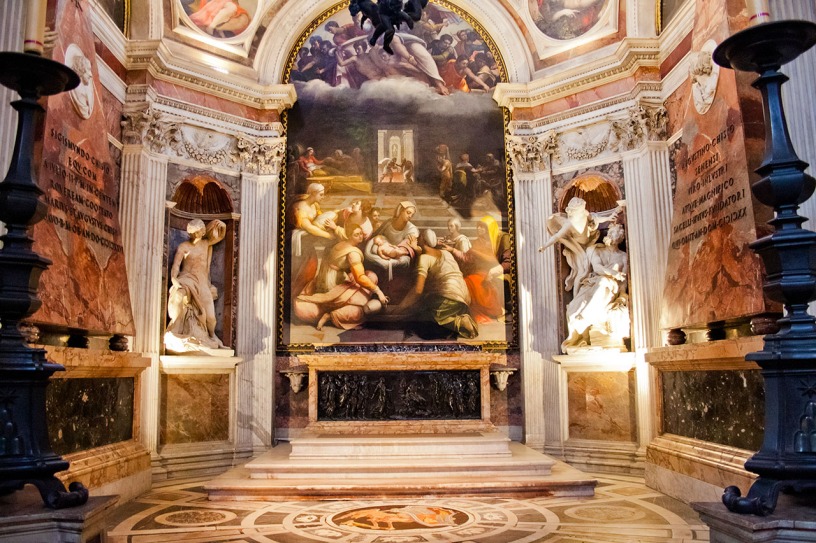Buongiorno and welcome to Rome Cabs Italy travel blog! Tucked away within the grandeur of the Basilica of Santa Maria del Popolo in Rome lies a hidden gem, the Chigi Chapel, also known as the Chapel of the Madonna of Loreto. This sacred space is a testament to the convergence of art, history, and spirituality, preserving the genius of Raphael and later enhanced by the masterful touch of Gian Lorenzo Bernini. Join us as we explore the marvels of Chigi Chapel on a journey through time and art.
.
Who did the Chigi Chapel belong to?
In the early 16th century, Pope Julius II, the influential pope bestowed upon his friend, Agostino Chigi, the esteemed privilege of acquiring a chapel within the illustrious Basilica of Santa Maria del Popolo in Rome. This generous grant initiated a remarkable journey, laying the foundation for what would evolve into a masterpiece of religious architecture and art.
Agostino Chigi, a wealthy Sienese banker and financier of the Roman Curia, seized this rare opportunity to secure a place of profound significance within the sacred confines of the basilica. The chapel, originally dedicated to Saints Sebastian, Roch, and Sigismund, underwent a transformation guided by Agostino’s deeply rooted devotion to the Madonna of Loreto. In a papal bull issued on December 3, 1507, the dedication of the chapel was officially altered to honor the Madonna of Loreto, reflecting Agostino’s passionate devotion to this revered figure.
.
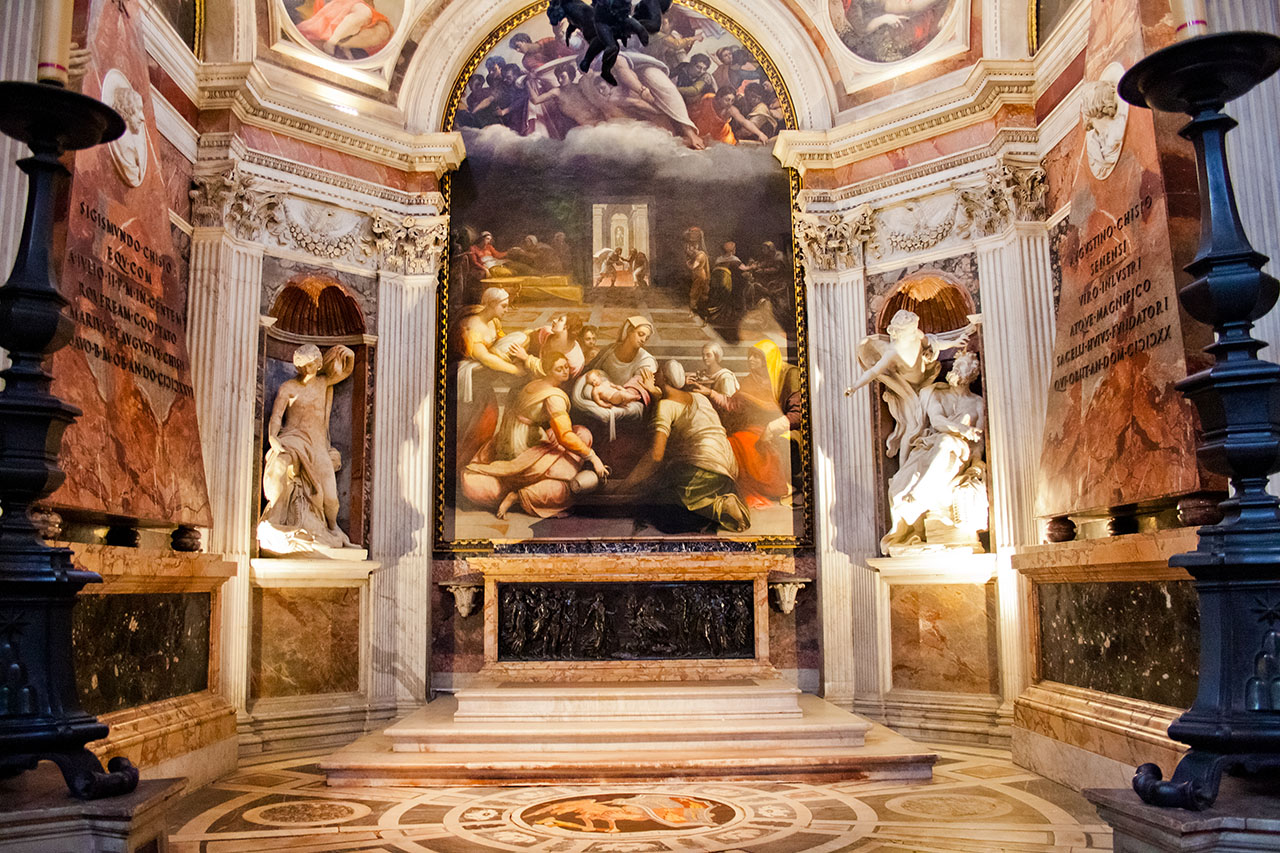
.
Thus, the Chigi Chapel emerged as a testament to the personal connection between Julius II and Agostino Chigi, a manifestation of the profound bond between a powerful pontiff and a prominent banker. This initial act of patronage set the stage for the subsequent architectural and artistic endeavors that would unfold in the hands of luminaries such as Raphael and Gian Lorenzo Bernini, solidifying the chapel’s status as a jewel within the Basilica of Santa Maria del Popolo.
Agostino Chigi found his eternal repose within the half-finished chapel in 1520, and the simultaneous deaths of the patron, artist, and patron’s widow slowed progress. Sigismondo Chigi, Agostino’s brother, later commissioned Lorenzetto to carry on Raphael’s plan in 1521.
.
Raphael’s Vision for the Chigi Chapel
.
The Chigi Chapel, with its profound spiritual significance, owes much of its architectural brilliance to the visionary mind of Raphael, one of the eminent maestros of the Renaissance. Tasked with the responsibility of reconstructing the chapel, Raphael embarked on a creative journey that would leave an indelible mark on the landscape of religious art and architecture.
.
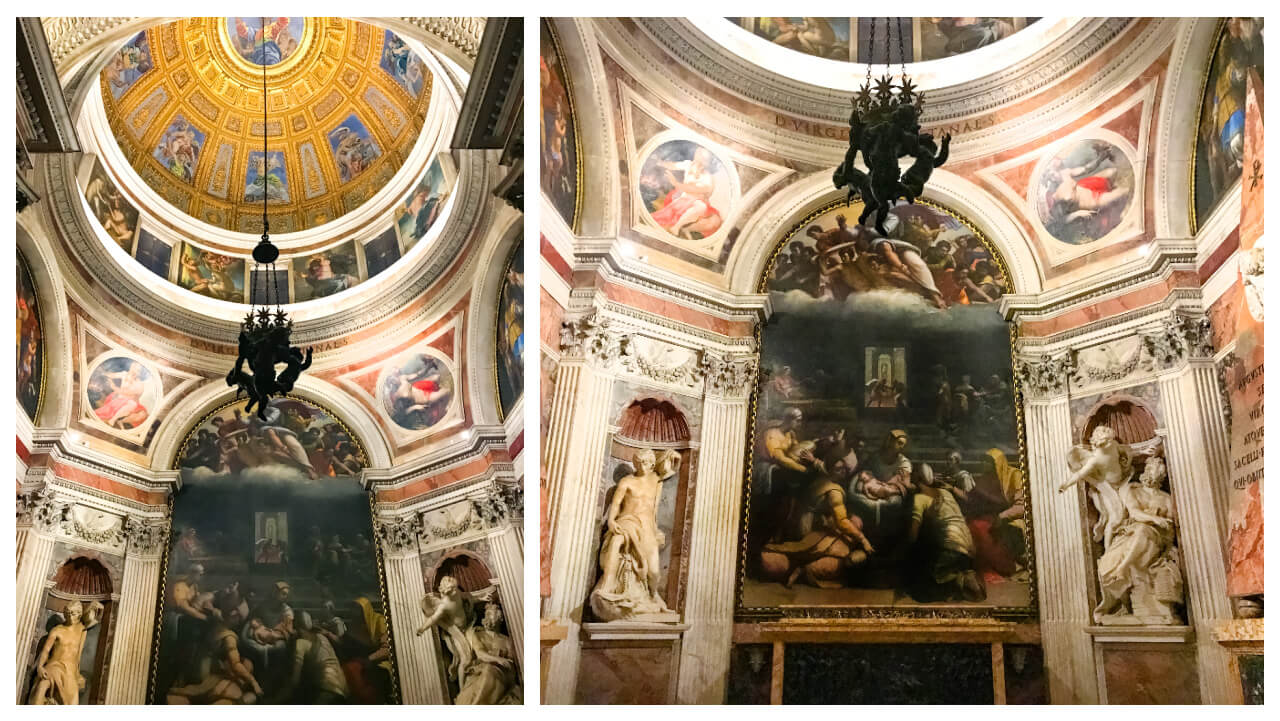
.
Raphael’s architectural prowess and artistic genius were brought to bear as he conceptualized the chapel’s reconstruction. At the heart of his design was a central theme that resonated with the very essence of Christian theology—the Resurrection. The chapel was envisioned as a visual narrative that intricately wove together elements of Christianity and classical antiquity, creating a harmonious synthesis of two seemingly disparate worlds.
Despite Raphael’s untimely death in 1520, his vision for the chapel endured, casting a lasting influence on the artistic direction that would follow. The torch was passed to Lorenzetto, who, under Raphael’s patronage, assumed the responsibility of carrying forth the master’s vision to completion. It was a testament to the collaborative spirit of the Renaissance, where the legacy of a revered artist could transcend mortality, living on through the skilled hands of a successor.
Lorenzetto, entrusted with the continuation of Raphael’s work, faced the challenge of not merely replicating the original designs but channeling the spirit and intention behind them. The chapel became a canvas where Lorenzetto skillfully crafted the Resurrection theme, ensuring that Raphael’s legacy remained intact in every architectural detail and artistic element.
.
Bernini’s A Baroque Transformation
.
Gian Lorenzo Bernini, a luminary of the Baroque movement, approached the Chigi Chapel with a vision that harmonized with the existing Renaissance elements while infusing it with the dynamic and ornate style characteristic of the Baroque era. The result was a synthesis of artistic traditions that celebrated both the continuity of Raphael’s vision and the innovation of Baroque aesthetics.
One of the prominent features of Bernini’s intervention was the completion of the pyramids, a design element initiated during Raphael’s time but left unfinished due to various circumstances. Fabio Chigi, recognizing the importance of fulfilling this aspect of the chapel’s original design, entrusted Bernini with the task. The pyramids, symbolic structures resonating with ancient and funereal associations, took their final form under Bernini’s meticulous craftsmanship.
The elevation of the altar, the laying of a new floor, and various other enhancements contributed to the overall opulence of the chapel. The synergy between Fabio Chigi’s patronage and Bernini’s artistic prowess resulted in a harmonious integration of architectural elements, decorative details, and religious symbolism.
The Chigi Chapel, once a testament to Raphael’s vision, now bore the imprint of the Baroque period’s exuberance and theatricality. Bernini’s touch infused a renewed sense of dynamism, dramatic flair, and emotional engagement, inviting visitors to experience the sacred space with heightened intensity.
.
Dome of Celestial Splendor
.
Luigi da Pace, a Venetian mosaicist, breathed life into the dome following the inspiration drawn from Raphael’s initial cartoon. The central roundel at the zenith of the dome is a sublime depiction of God, encircled by playful putti, celestial beings that infuse the scene with an aura of divine joy. This central composition stands as a visual anchor, radiating a sense of cosmic order and divine presence.
.
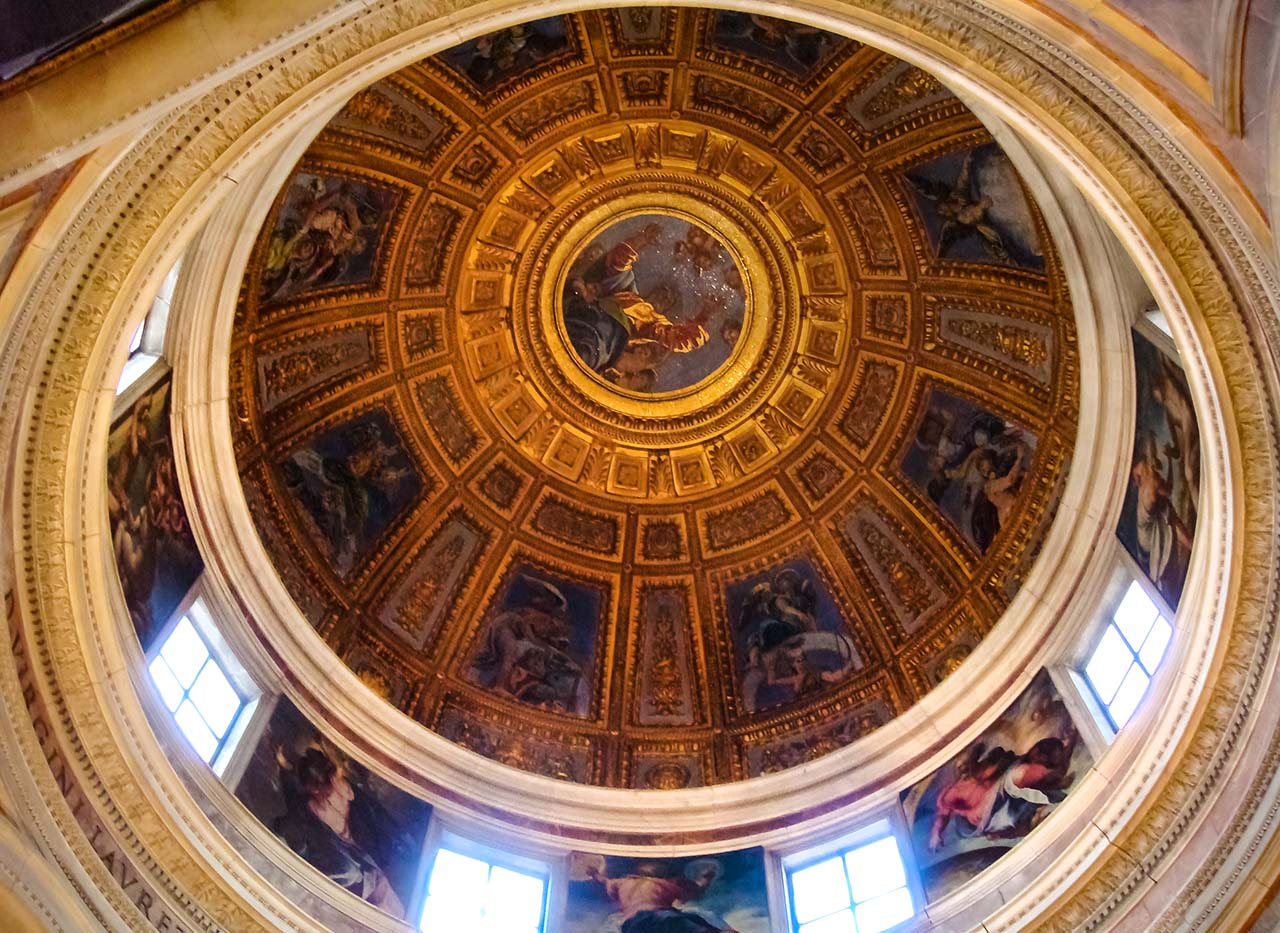
.
Surrounding this central motif, eight meticulously crafted mosaic panels unfold a celestial spectacle that transcends mere representation. Each panel serves as a celestial tableau, illustrating the Sun, Moon, stars, and planets personified as pagan deities.
The planets, in half-length forms, are accompanied by angels with vibrant, feathered wings. This unique synthesis of classical mythology and Christian symbolism reflects the prevailing spirit of the Renaissance and Baroque periods, where artistic expression became a vessel for the convergence of diverse cultural and religious influences.
.
Prophetic Statues of the Chigi Chapel
.
The statues of prophets, positioned within ornate shell-headed niches, are a harmonious blend of the creative visions of Raphael and Bernini. These prophetic figures, standing as sentinels of spiritual wisdom, reflect the seamless transition between the Renaissance and Baroque periods within the chapel’s sacred confines.
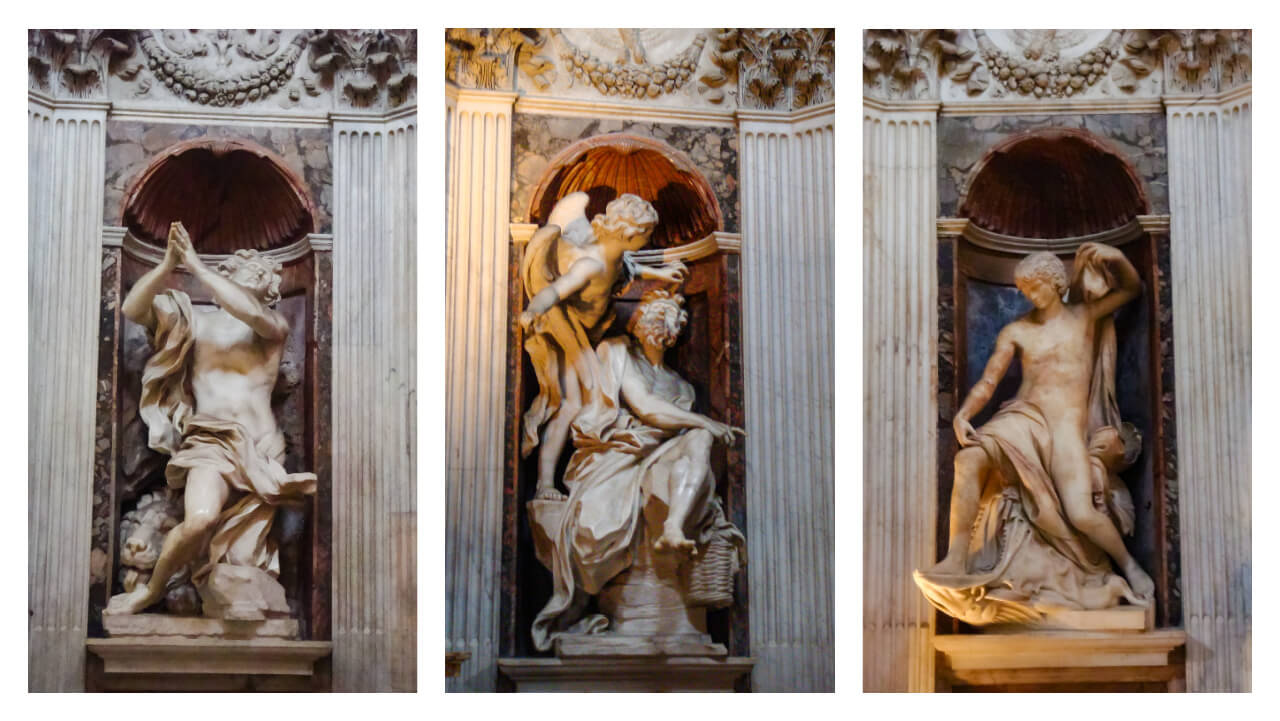
.
Each statue is a testament to the evolving artistic traditions, with Raphael’s initial designs providing the foundation and Bernini’s masterful touch infusing them with the dynamic energy characteristic of the Baroque style.
These statues serve as silent storytellers, communicating tales of faith and divine revelation. Whether it be the prophet Jonah prefiguring the Resurrection or Elijah, the desert-dweller sustained by divine grace, each figure contributes to the overarching thematic richness of the Chigi Chapel. Their placement within the shell-headed niches, a design element inspired by Raphael, creates a visually engaging ensemble, drawing visitors into a contemplative dialogue with the prophetic voices of antiquity.
.
Pyramidal Tombs of the Chigi Chapel
.
Adjacent to these statues, the pyramidal tombs of Agostino and Sigismondo Chigi stand as enduring symbols of eternity and the transcendence of the mortal realm. Conceived by Raphael in their original design, these tombs took on their final form during the Baroque era under the hands of Gian Lorenzo Bernini.
.
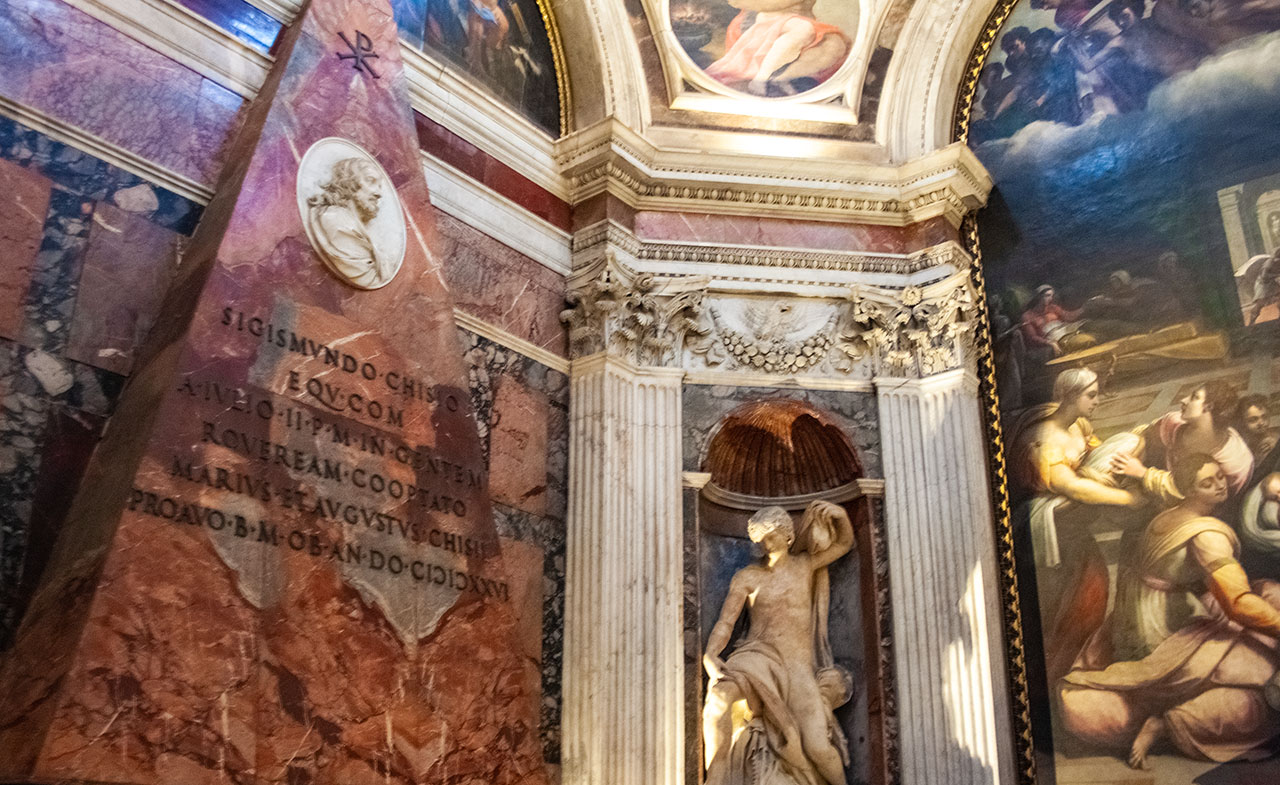
.
The pyramidal form of the tombs, reminiscent of ancient Egyptian symbols and imperial funerary monuments, reflects the classical influence prevalent in Renaissance thought. The ratio of height to width in the Chigi Chapel, mirroring ancient Egyptian obelisks, further emphasizes the connection to antiquity. The slender, elongated silhouette of the tombs echoes the architectural grace of the obelisks that once adorned the squares of ancient Rome.
Bernini’s intervention in completing and simplifying the tombs during the Baroque era marked a transformative phase for these monumental structures. The sculptural elements on the tombs, originally envisioned by Raphael, saw simplification, and Bernini, with his innate ability to infuse drama into his works, ensured that the pyramidal tombs seamlessly integrated with the dynamic spirit of the Baroque aesthetic.
.
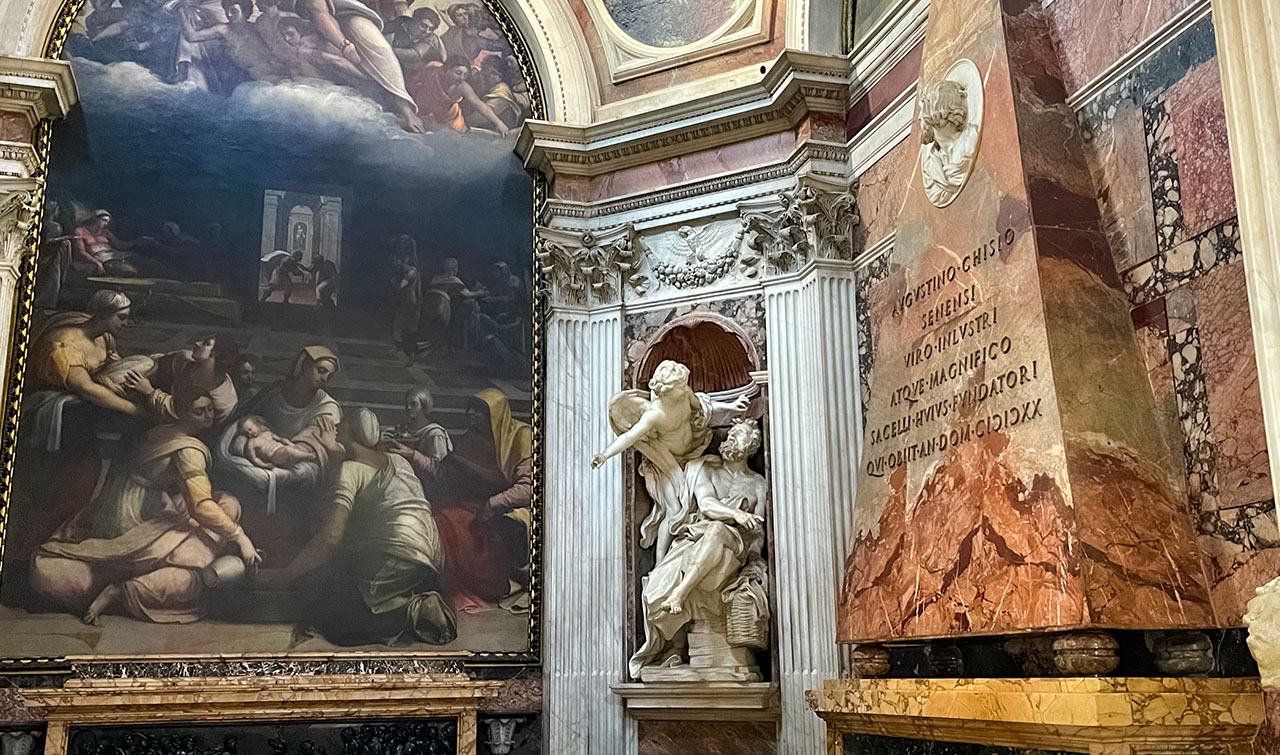
.
Transcending Mortality: Bernini’s Geometric Pavement
.
The current floor in the area was designed by Bernini. He closed off an old opening near the altar and raised the altar by two steps to make it more important symbolically. The original steps were very elegant, made of big blocks of marble. The floor itself is made of white and grey marble with a pattern that matches the dome’s decoration. In the middle, there’s a special design with a winged skeleton holding the Chigi family’s coat of arms.
This symbolizes how their family virtues triumph over death. Below the skeleton, there’s a Latin phrase Mors Ad Caelos that means “through death to heaven“, with capital letters that also represent the year 1650, when the reconstruction started. The design was made by a stonecutter named Gabriele Renzi in 1653-54, but historical records show that the original Latin phrase included one more word, making the year represented 1651 instead.
.
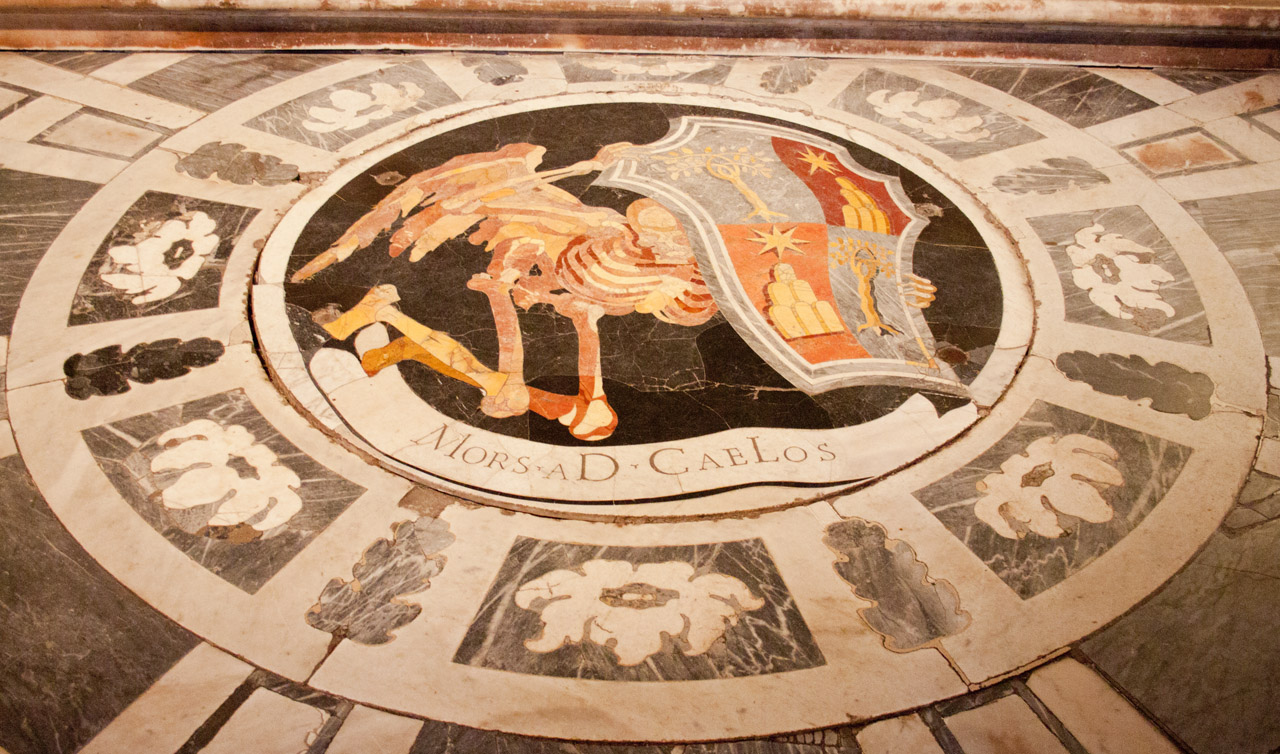
.
Chigi Chapel in Pop Culture
.
The allure of the Chigi Chapel extends beyond its sacred walls, finding a place in popular culture. In Dan Brown’s “Angels & Demons“, the sculpture of Habakkuk and the Angel becomes a crucial element, leading protagonists on a thrilling quest.
The Chigi Chapel stands as a testament to the enduring beauty of Renaissance and Baroque art. As you step into this sacred space, you’ll find yourself immersed in a world where the divine, the artistic, and the historical converge, inviting you to contemplate the profound connections between earthly and eternal realms.
.
DISCOVER MORE OF ROME with ROMECABS:
Sant’Ignazio Church’s Fake Dome Illusion
The Rich History of Santa Maria in Trastevere Church in Rome
Beyond the Colosseum: Exploring Rome’s Hidden Architectural Gems
TIPS on selecting the Best Tour Company in Rome for Private Shore Excursions from Civitavecchia
10 Common Mistakes that Ruin your Summer Trip to Italy
.
* Find us online also on:
